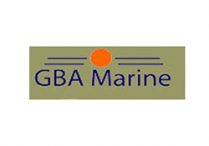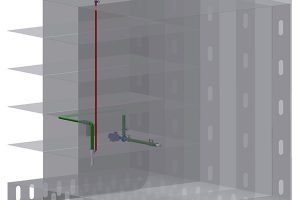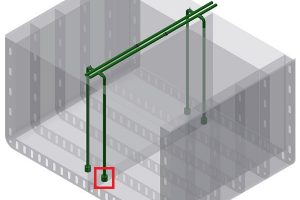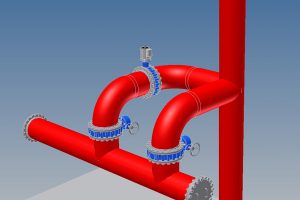GBA Marine is an engineering company founded in 2004, who developed a cost-efficient solution to recovery of VOC during offshore transport of crude oil.
The cost efficient VOC is based on direct absorption technology .
The CVOC system is based on direct absorption of VOC in the crude oil. The Swirl Absorber, a combined ejector and mixing unit, is using crude oil from one of the cargo tanks to create a low-pressure area where vapor from the main inert gas line can be mixed with crude oil. The mix of small, typically 1mm diameter, bubbles of VOC and inert gas with crude oil is then led back into the bottom of a cargo tank. The small gas bubbles rise very slowly, allowing VOC to be absorbed in the crude oil due to the hydrostatic pressure in the bottom of the cargo tank, while inert gas rises towards the surface.
By absorbing VOC back into the crude oil, cargo tank pressure is reduced without venting to the atmosphere. The GBA CVOC (Compact VOC) system can be used for a number of applications, including 100% elimination of VOC emissions during transport and significant reduction of VOC emissions during loading and lightering operations.
In addition to environmental and economical benefits installing the CVOC emission reduction system from GBA Marine also increases operational safety. The GBA CVOC system reduces tank pressure without bleeding to the atmosphere, which means that the risk of releasing H2S or other hazardous vapors into the ventilation system of the living quarters is eliminated. In addition it replaces manual venting, thus avoiding sending crew members on deck in rough weather.
GBA Marine Products:
CVOC™ Transport System:
The CVOC™ Transport System is an upgraded version of the original GBA Marine VOC recovery system with lower power consumption, reduced weight and higher efficiency. It has been especially developed for use on conventional terminal tankers where spare power reserves are limited. Altough the CVOC™ Transport System is mainly designed for use during offshore transport of crude oil, it is also possible to operate during loading. In this case absorption capacity will be reduced until the cargo tank where the CVOC™ Transport System is installed is full.
CVOC™ Loading System:
Based on the well-proven CVOC™ system that have been in successfull operation onboard crude oil tankers around the world since May 2007, GBA Marine has developed the CVOC™ Loading System. The loading system is based on the same principles as the original CVOC™ system, but has been tailored to increase efficiency during loading operations. A wide variety of pump arrangements are available, including deep-well pumps with hydraulic- or electric drive system. Pipe routing is extremely flexible, and there are no particular requirements except general good piping practices.
CVOC™ back-pressure system (CVOC™ Loading / Transport System option):
The optional back-pressure system is designed to increase efficiency of the CVOC™ system during loading by allowing the cargo tank pressure to build up during the loading process, and then keep this at a steady high level throughout the loading by throttling an automatic valve installed in a bypass to the vessel’s mast riser.
The bypass is used to ensure that the mast riser can operate normally in the unlikely case of any system malfunction, and continues the philosophy behind keeping the CVOC™ system as a stand-alone installation without interference with existing procedures and safety features.
The philosophy behind the back-pressure system is well proven, and several similar soultions already exist. As an example INTERTANKO and OCIMF has recommended to keep cargo tank pressure as high as possible during loading and transport in their “Guidelines for the development of a VOC management plan” (see item 1.4.2). However, increasing the cargo tank pressure alone will not be sufficient to eliminate emissions, and manual operation of the mast riser valve will expose the crew to hydrocarbons.
GBA Dropline Termination:
In the early stage of loading crude oil tankers, a lot of VOC is generated due to current dropline design. Crude enters the cargo tank with relatively high velocity, often through a straight pipe terminated a short distance above the tank top, causing splashing and stirring of the cargo. Both destabilizes the crude by increasing area between gas and liquid, thus accellerating emission of VOC.
In order to reduce this effect and limit VOC emissions in the early stages of the loading process, GBA Marine has developed a dropline termination device that can be installed on both newbuildings and retrofit on existing vessels (some hot-work required). The device reduces flow velocity by a factor of ten, thus significantly limiting the stirring effect from the loading process.The design also eliminates splashing by directing the crude into a partly enclosed chamber prior to leading it into the cargo tank.
In-line Inert Gas Cleaner (IGC):
The Inert Gas Cleaner (IGC) is based on patented in-line cyclone technology, and efficiently removes water, soot and other particles from the gas stream. By removing up to 100 % of water contained in the inert gas, the IGC reduces corrosion of piping and cargo tanks to a minimum.
The IGC can be installed after the inert gas generator, after the deck water seal, or preferably in both locations for maximum protection of the inert gas piping. The IGC requires no control system or monitoring, and has no impact on existing safety features. The compact and light weight unit is made of stainless steel, is self-cleaning and virtually maintenance free.
The Inert Gas Cleaner may also be used for other purposes where particles and/or liquid need to be removed from a gas stream, and can be tailored to meet separation requirements down to five microns.
Please contact GBA Marine for a more detailed presentation of our products.











